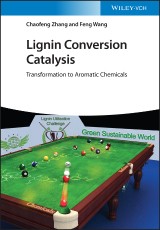Details

Lignin Conversion Catalysis
Transformation to Aromatic Chemicals1. Aufl.
|
142,99 € |
|
| Verlag: | Wiley-VCH |
| Format: | EPUB |
| Veröffentl.: | 19.08.2022 |
| ISBN/EAN: | 9783527835027 |
| Sprache: | englisch |
| Anzahl Seiten: | 464 |
DRM-geschütztes eBook, Sie benötigen z.B. Adobe Digital Editions und eine Adobe ID zum Lesen.
Beschreibungen
<b>Lignin Conversion Catalysis</b> <p><b>Authoritative reference providing comprehensive knowledge on the lignin conversion process with recent developments of mechanisms and techniques</b> <p><i>Lignin Conversion Catalysis: Transformation to Aromatic Chemicals</i> covers the strategy, catalysis, and mechanisms of cleaving lignin linkages to aromatic chemicals and crucially elaborates on the specifics of multiple original lignins. Sample topics covered in the work include: <ul><li>Lignin depolymerization, models, and techniques of various lignins by heterogeneous substrates (such as native lignins, Kraft lignins, and organosolv lignins)</li> <li>Cleavage methods for lignins (such as oxidation and hydrogenation) as well as their main products (such as arenes, phenol, and acid)</li> <li>Relationships among the strategy/method, catalyst, and mechanism when viewed from the cleavage order and the type of corresponding chemical bonds</li> <li>Commercial components of lignin, a globally available raw material with many applications in drug design, polymers, and more</li></ul> <p>Organic chemists, polymer chemists, and chemical engineers can use the valuable information contained in <i>Lignin Conversion Catalysis: Transformation to Aromatic Chemicals</i> to get up to date on this new raw material and understand the various developments that have been made in the field to make it viable for industrial purposes.
Part I Book introduction<br> 1. Background and overview<br> <br> Part II Understanding about the lignin<br> 2. Lignin biosynthesis, structure, and physicochemistry properties<br> 3. Lignin isolation and lignin pre-chemical modification<br> 4. Lignin detection, quantification and structure characterization <br> <br> Part III Lignin depolymerization: scientific questions, challenges and current progress<br> 5. Scientific questions for lignin conversion and new biorefinery<br> 6. Brief summary of methods for lignin depolymerization<br> <br> Part IV Strategies review on lignin linkages cleavage involved in lignin depolymerization via the inverse disassembly analysis<br> 7. The inverse disassembly analysis (IDA) method for classifying lignin conversion methods/strategies<br> 8. Direct lignin C-Oar, ArO-Ar or C-Ar bonds cleavage without first activation of the adjacent chemical bonds<br> 9. Lignin linkages cleavage beginning with phenolic hydroxyl group dehydrogenation or first aromatic rings activation<br> 10. Lignin linkages cleavage beginning with C alpha-H or ArO-H heterolysis<br> 11. Lignin linkages cleavage beginning with C alpha-OH bond heterolysis<br> 12. Lignin linkages cleavage beginning with the activation of C alpha-H, C alpha-OH or C alpha O-H bonds via non-ionized routes<br> 13. Lignin linkages cleavage beginning with C beta-H direct activation<br> 14. Lignin linkages cleavage beginning with C gamma-H or C gammaO-H direct activation<br> 15. Lignin depolymerization strategies considering fragments condensation<br>
<p><b><i>Dr. Chaofeng Zhang</b> received his PhD in Organic Chemistry from Dalian Institute of Chemical Physics (DICP), Chinese Academy of Sciences, under the supervision of Professor Feng Wang in 2017, then joined the DICP as an Assistant Professor. In 2022, he joined Nanjing Forestry University (NFU) and was promoted to full Professor.</i></p> <p><b><i>Professor Feng Wang</b> received his PhD in Physical Chemistry from Dalian Institute of Chemical Physics (DICP), Chinese Academy of Sciences, in 2005, then joined DICP and was promoted to full Professor in 2011. </i>
<p><b>Authoritative reference providing comprehensive knowledge on the lignin conversion process with recent developments of mechanisms and techniques</b></p> <p><i>Lignin Conversion Catalysis: Transformation to Aromatic Chemicals</i> covers the strategy, catalysis, and mechanisms of cleaving lignin linkages to aromatic chemicals and crucially elaborates on the specifics of multiple original lignins. Sample topics covered in the work include: <ul><li>Lignin depolymerization, models, and techniques of various lignins by heterogeneous substrates (such as native lignins, Kraft lignins, and organosolv lignins)</li> <li>Cleavage methods for lignins (such as oxidation and hydrogenation) as well as their main products (such as arenes, phenol, and acid)</li> <li>Relationships among the strategy/method, catalyst, and mechanism when viewed from the cleavage order and the type of corresponding chemical bonds</li> <li>Commercial components of lignin, a globally available raw material with many applications in drug design, polymers, and more</li></ul> <p>Organic chemists, polymer chemists, and chemical engineers can use the valuable information contained in <i>Lignin Conversion Catalysis: Transformation to Aromatic Chemicals</i> to get up to date on this new raw material and understand the various developments that have been made in the field to make it viable for industrial purposes.

















